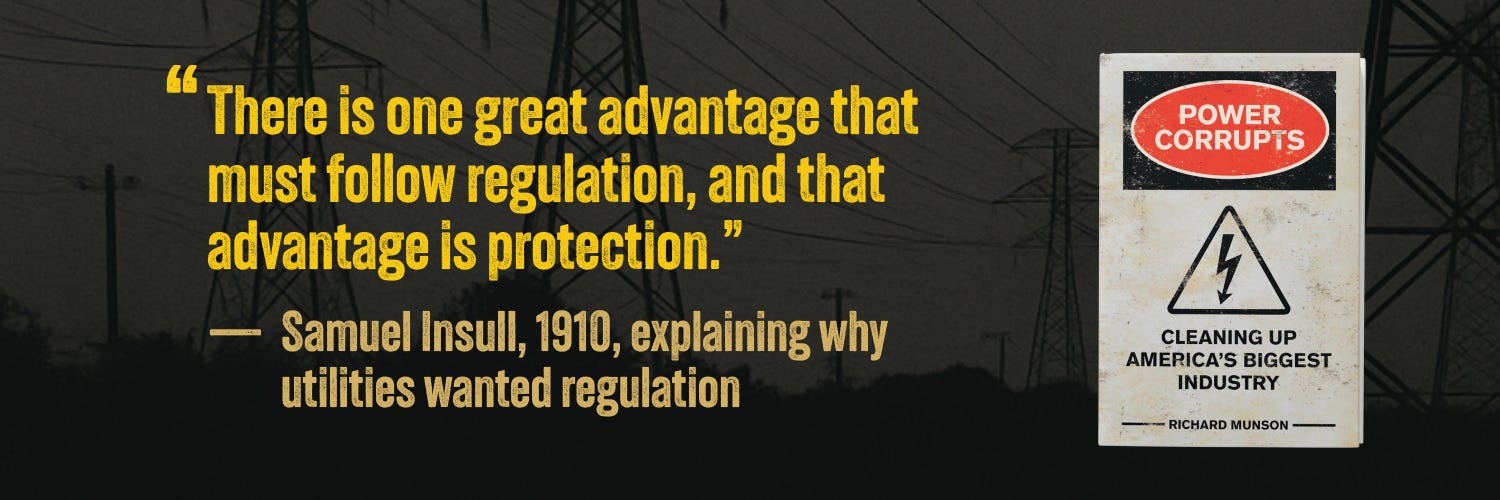To understand how we got Chuck Jones and Michael Madigan, we need to go back to the man who created the template for utility corruption over a century ago. Meet Samuel Insull—the mastermind who invented the monopoly deal that still governs utilities today.
The Rise of a Monopolist
How did electricity corporations become billion-dollar behemoths? Although they usually trace their roots to Thomas Edison and his founding of the Edison Illuminating Company in 1880, perhaps more responsible for the industry's basic structure is Samuel Insull, who arrived in New York City a year later at the age of twenty-one to be Edison's personal secretary.
Insull began his career by answering Edison's mail, organizing his office, and buying his clothes. In 1892, when Edison was ousted from his own company, Insull moved to Chicago and bought a power station there. Demonstrating what the inventor described as "a positive gift for borrowing money," Insull quickly moved to financing generators, bribing politicians, and buying up competitors. Within forty years, his empire spanned 32 states and he became admired as a business tycoon. Thirteen years later, he would be arrested for racketeering. His legacies from that wild journey are monopolized utilities, manipulated regulators, and malfeasant executives.
Creating the Deal
As Insull and other energy moguls bribed local politicians for permits needed to string wires across or under city streets, calls for reform grew. Unlike his power-company colleagues who abhorred government oversight, Insull joined Robert LaFollette and other progressives to criticize municipal corruption and advance "scientific" management. His goal was to strike a bargain that continues to dominate the industry--power companies get to be monopolies in exchange for some state regulation. As the executive put it, "There is one great advantage that must follow regulation, and that advantage is protection."
The Regulatory Compact
Wisconsin in 1907 became the first to pass legislation creating "an independent commission of experts" to approve rates for privately owned utilities. New York and Massachusetts followed soon thereafter, and within nine years thirty more states regulated power monopolies.
This arrangement convinced investors that utilities were safe bets. With assured returns on their every investment, utilities gained an incentive to build more and more generators and transmission lines, enabling Insull's expansionistic plans. Their construction expenses rose rapidly, from about $500 million in 1902, to more than $1 billion in 1907, and to almost $2 billion in 1912.
Why This Matters to You
Samuel Insull's "regulatory compact" from 1907 is the same basic deal governing your utility today: they get guaranteed monopoly territories and returns on investment, while regulators supposedly protect consumers. But as Insull himself admitted, regulation's "great advantage" was "protection"—for utilities, not customers. This system gave companies every incentive to build expensive infrastructure (since they profit from every dollar spent) while shielding them from competition. When Chuck Jones bribed politicians for bailouts, he was exploiting a system Insull designed over a century ago. The corruption isn't a bug—it's a feature of monopoly power.
Next Week
Monopoly power shielded utility executives from competition, but it couldn't shield them from their own greed. Next week: How Insull's system immediately bred corruption, leading to bribery scandals, stock manipulation, and the first utility executive to flee the country as a fugitive.




Hi Richard. My friend, Al Grosboll, shared your postings about the electric utility industry with me. I’ve really enjoyed your first few postings. If you are ever interested I’d be happy to share my master’s degree research and thesis with you as they pertain to both the history of ComEd as well as the influence in selected states of electric utilities and their political contributions apparent influence on individual state legislatures. Keep up the great work!
Gene Reineke (lacal6591@gmail.com).